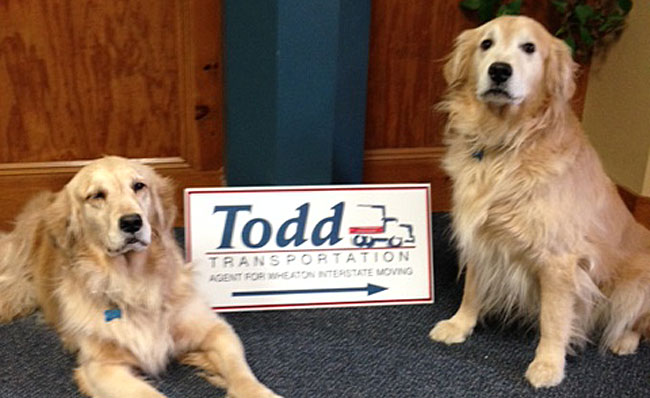Managing Your Pets During Your Move

Pets have an instinctive fear of new surroundings, so pet owners will want to help them adjust quickly after moving to a new home. Todd mascots Hunter and Daisy share the following tips to help you do just that.
Relocation of pets
- Pets cannot be shipped on moving vans.
- Pets often become frightened and may try to run away. Keep your pet on a leash when outside.
- Your pet should wear a special identification tag with its name, your name and where you can be reached.
- Consider sending smaller pets by air express.
- Consult with your veterinarian concerning mild sedation of your pet during the trip.
Entry requirements
- If your move is across state lines, check with your new State Veterinarian or State Department of Animal Husbandry. A good place to start is the U.S. State and Territory Animal Import Regulations website.
- Interstate health certificates must be obtained for dogs and horses prior to entering most states.
- States require a rabies vaccine for dogs and many require it for cats. Hawaii requires that cats and dogs be quarantined for 120 days.
- Some pets must have an entry permit issued by the destination state’s regulatory agency.
- A few states have border inspection of all animals being transported; others have random inspections.
Local laws
- Be sure to check your local community laws. Some communities have pet control and licensing ordinances. In some cases, the number of pets is limited.
Air travel checklist
- Make reservations well in advance. Follow airline instructions.
- Obtain a shipping container a week or two in advance. Familiarize your pet with it by placing the pet in it for a few minutes each day. Gradually lengthen the time until the pet seems to be at ease with it.
- Carefully schedule boarding and shipping arrangements for your pet to assure that the pet is well cared for until you are able to receive it at your new home.
- Feed the pet no less than five or six hours before flight time. Give the pet a drink of water no less than two hours before the flight.
- If your pet is accompanying you, arrive at the terminal 45 minutes before normal check-in time.
- If shipping the pet, get to the freight terminal two hours in advance of the flight.
- Be certain that names, addresses and telephone numbers of people responsible for the pet at origin and destination are clearly marked on the container and on the pet’s identification tag.
- Notify the person receiving the pet that it is on the way. Give them the flight and waybill number.
- Pets can usually be picked up within 90 minutes of flight arrival.
Car travel checklist
- If your dog or cat is not used to traveling by car, make short trips with the pet a week or two in advance.
- Dogs should be taught to lie quietly. Don’t let your dog put its head in the wind as that can irritate its eyes and cause problems.
- Cats are often frightened by car travel, but they usually adjust quickly.
- Folding kennels or crates especially designed for minivans can be very useful.
- Get your pet accustomed to being on a leash and always use it when outside your vehicle or hotel.
- If you must stop overnight, check in advance for hotels that allow pets.
- Be sure that your pet is properly tagged and its rabies tag is firmly attached.
- Pet travel kits should include the following: food, water, dishes, leash, treats, favorite toy, some type of bedding and a can opener (if needed).
- To be on the safe side, ask your veterinarian if a sedative would be appropriate.
- Don’t forget the scooper and plastic bags for cleanup!
